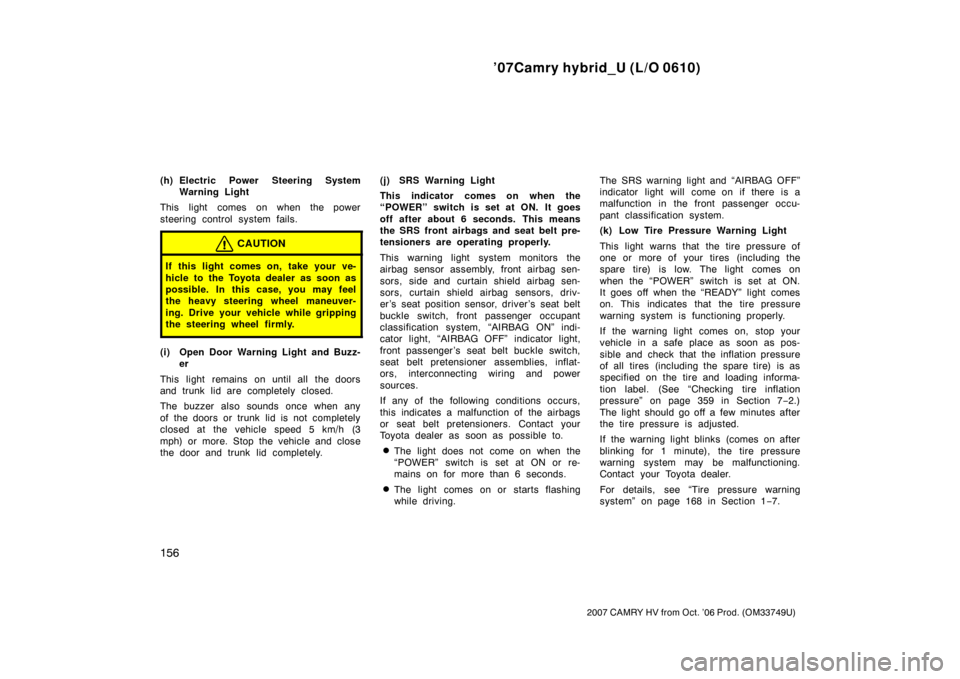Page 9 of 405

’07Camry hybrid_U (L/O 0610)
ix
2007 CAMRY HV from Oct. ’06 Prod. (OM33749U)
Smart key system
Users of any electrical medical devices such as im-
planted pacemakers should consult the manufacturer of
the device for information about its operation under the
influence of radio waves. Radio waves could have unex-
pected effects on the operation of such medical devices.
For details, see “Keys” on page 22 in Section 1−2.
Tires and loading on your
To y o t a
Underinflated or overinflated tire pressure and the
excess load may result in the deterioration of
steering ability and braking ability, leading to an
accident. Check the tire inflation pressure periodi-
cally and be sure to keep the load limits given in
this Owner ’s Manual. For details about tire inflation
pressure and load limits, see pages 359 and 295.
Leak detection pump
This pump performs fuel evaporation leakage check. This
check is done approximately five hours after the hybrid
system is turned off. So you may hear s ound coming from
underneath the trunk for several minutes. It does not indi-
cate a malfunction.
Hybrid battery
The hybrid battery has a limited service life. Call your
Toyota dealer or a qualified service shop for information
about re cycling or disposal of the battery.
Page 163 of 405
’07Camry hybrid_U (L/O 0610)
151
2007 CAMRY HV from Oct. ’06 Prod. (OM33749U)
If the indicator or buzzer comes on...Do this.
(g)orTake vehicle to Toyota dealer.
If red brake system warning light is also on, stop immediately and contact Toyota deal-
er.
(h)Take vehicle to Toyota dealer.
(i)
(indicator and buzzer)
Close all doors and trunk lid.
(j)Take vehicle to Toyota dealer immediately.
(k)Adjust tire inflation pressure (including spare tire). If the light comes on after blinking
for 1 minute, contact Toyota dealer.
(l)Read a message on multi−information display.
(m)Parking brake reminder buzzerRelease parking brake.
Page 168 of 405

’07Camry hybrid_U (L/O 0610)
156
2007 CAMRY HV from Oct. ’06 Prod. (OM33749U)
(h) Electric Power Steering SystemWarning Light
This light comes on when the power
steering control system fails.
CAUTION
If this light comes on, take your ve-
hicle to the Toyota dealer as soon as
possible. In this case, you may feel
the heavy steering wheel maneuver-
ing. Drive your vehicle while gripping
the steering wheel firmly.
(i) Open Door Warning Light and Buzz- er
This light remains on until all the doors
and trunk lid are completely closed.
The buzzer also sounds once when any
of the doors or trunk lid is not completely
closed at the vehicle speed 5 km/h (3
mph) or more. Stop the vehicle and close
the door and trunk lid completely. (j) SRS Warning Light
This indicator comes on when the
“POWER” switch is set at ON. It goes
off after about 6 seconds. This means
the SRS front airbags and seat belt pre-
tensioners are operating properly.
This warning light system monitors the
airbag sensor assembly, front airbag sen-
sors, side and curtain shield airbag sen-
sors, curtain shield airbag sensors, driv-
er ’s seat position sensor, driver ’s seat belt
buckle switch, front passenger occupant
classification system, “AIRBAG ON” indi-
cator light, “AIRBAG OFF” indicator light,
front passenger ’s seat belt buckle switch,
seat belt pretensioner assemblies, inflat-
ors, interconnecting wiring and power
sources.
If any of the following conditions occurs,
this indicates a malfunction of the airbags
or seat belt pretensioners. Contact your
Toyota dealer as soon as possible to.
�The light does not come on when the
“POWER” switch is set at ON or re-
mains on for more than 6 seconds.
�The light comes on or starts flashing
while driving.The SRS warning light and “AIRBAG OFF”
indicator light will come on if there is a
malfunction in the front passenger occu-
pant classification system.
(k) Low Tire Pressure Warning Light
This light warns that the tire pressure of
one or more of your tires (including the
spare tire) is low. The light comes on
when the “POWER” switch is set at ON.
It goes off when the “READY” light comes
on. This indicates that the tire pressure
warning system is functioning properly.
If the warning light comes on, stop your
vehicle in a safe place as soon as pos-
sible and check that the inflation pressure
of all tires (including the spare tire) is as
specified on the tire and loading informa-
tion label. (See “Checking tire inflation
pressure” on page 359 in Section 7−
2.)
The light should go off a few minutes after
the tire pressure is adjusted.
If the warning light blinks (comes on after
blinking for 1 minute), the tire pressure
warning system may be malfunctioning.
Contact your Toyota dealer.
For details, see “Tire pressure warning
system” on page 168 in Section 1 −7.
Page 307 of 405

’07Camry hybrid_U (L/O 0610)
295
2007 CAMRY HV from Oct. ’06 Prod. (OM33749U)
Vehicle load limits include total load
capacity, seating capacity, towing ca-
pacity and cargo capacity. Follow the
load limits shown below. Total load ca-
pacity and seating capacity are also
described on the tire and loading in-
formation label. For location of the tire
and loading information label, see
“Checking tire inflat ion pr es s ur e” on
page 359.
Total load capacity: 410 kg (900 lb.)
Total load capacity means com-
bined weight of occupants, cargo
and luggage. Tongue load is in-
cluded when trailer towing.
Seating capacity: Total 5 (Front 2, Rear 3)
Seating capacity means the maxi-
mum number of occupants whose
estimated average weight is 68 kg
(150 lb.) per person. Depending on
the weight of each person, the seat-
ing capacity given may exceed the
total load capacity.NOTICE
Even if the number of occupants are
within the seating capacity, do not ex-
ceed the total load capacity.
Towing capacity:
Toyota does not recommend towing
a trailer with your vehicle. It is not de-
signed for trailer towing.
Cargo capacity
Cargo capacity may increase or de-
crease depending on the size (weight)
and the number of occupants. For de-
tails, see “Capacity and distribution”
that follows.
CAUTION
Do not apply the load more than
each load limit. That may cause
not only damage to the tires, but
also deterioration to the steering
ability and braking ability, which
may cause an accident.
When stowing cargo and luggage in
the vehicle, observe the following:
� Put cargo and luggage in the trunk
when at all possible. Be sure all
items are secured in place.
� Be careful to keep the vehicle bal-
anced. Locating the weight as far
forward as possible helps maintain
balance.
� For better fuel economy, do not
carry unneeded weight.
Veh icle lo ad limit s Cargo and luggage—
—Stowage precautions